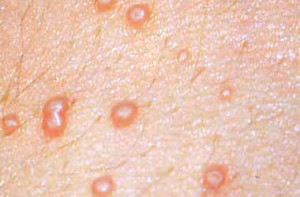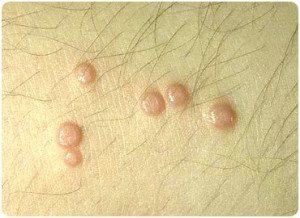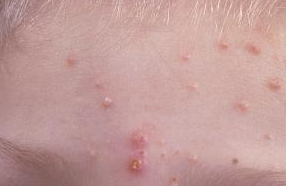What is Molluscum contagiosum ?
Molluscum contagiosum is a common skin disorder that is caused by viral infections and generally tends to affect infants and children. It results in the occurrence of painless papules or bumps which often vanish on their own, within a year. An injury or a scratch over the papules may affect the adjoining area of the skin.
On rare occasions molluscum contagiosum may affect the adults as well. Adults with active instances of sexually transmitted diseases may develop the skin condition in their genital area. Also, people with diminished immune system capacities are at greater risk to contact the viral infection.
Molluscum contagiosum is contagious and spreads by physical contact with an infected person or contact with contaminated materials. As such, all individuals affected by molluscum contagiosum are advised to seek immediate medical treatment.
Symptoms of molluscum contagiosum
Some of the signs and symptoms of molluscum contagiosum are mentioned below:
- Molluscum contagiosum causes circular and raised, flesh- colored papules or bumps on the skin surface.
- The top of such bumps have a characteristic indentation or dot
- The papules measure not bigger than about 2 to 5 mm or 1/4th of an inch in diameter
- It can be removed easily by scratching or by rubbing harshly, but such activities help the spread of infection onto the surrounding skin
- In children, the papules typically form over the neck, face, armpits, hands and arms, whereas, in adults, molluscum contagiosum may be a form of venereal disease and normally affects the genitals, inner areas of the upper thighs, buttocks and lower abdomen.
- On certain occasions, the bumps and the surrounding skin may get inflamed or red as a part of an abnormal action of the immune system. This may result in molluscum dermatitis.
- There are no serious health complications that result from molluscum contagiosum. It is different from genital warts, but people affected by the condition are recommended to consult a doctor and check for STDs.
- Sometimes, the lesions cause prickly sensations and when scratched, it may result in secondary infection. Molluscum contagiosum of the eyelids may result in complications such as conjunctivitis.
Causes of molluscum contagiosum
The causes of molluscum contagiosum are discussed below:
- An infection by a member of the poxvirus family referred to as the molluscum contagiosum virus, causes the skin disorder.
The spread of the virus can happen in many ways, which include:
- Any form of sexual contact or intimacy with an affected individual.
- Direct skin to skin contact with affected people
- Indirect contact with the virus through contaminated objects such as doorknobs, tables, toys and faucet handles.
- Scratching or rubbing the lesions or activities such as shaving can lead to the spread of infection to nearby areas.
- Persons with a compromised immune system are at a greater vulnerability to develop extreme forms of the blisters due to infection by the molluscum contagiosum virus.
- Molluscum contagiosum is extremely contagious. Hence people, who meet several business contacts on a daily basis or are required to travel a lot, are at greater risk to contact the virus through individuals who may be active carriers of the disease.
Molluscum contagiosum treatment
- In people with normal immune system, the skin condition resolves on its own, even without treatment, and the symptoms tend to get disappear within 6 months or within a year. Sometimes, it takes a few years for molluscum contagiosum to completely vanish.
- People with altered immune system or children with under-developed immune systems, may take more than a year to get rid of the infection.
- Molluscum contagiosum spreads quickly from one to another either directly or indirectly, and hence doctors’ advice prompt treatment for infection.
Molluscum contagiosum can be treated in the following ways:
- Cryotherapy which involves the freezing of the lesions by subjecting them to extremely low temperatures through different means
- Curettage which involves scraping off the papules with medical tools
- Laser therapy can be employed to destroy the papules
- These treatments methods can result in a lot of distress and discomfort. Hence topical anesthetics are recommended by physicians to alleviate the pain before carrying out such procedures.
- Topical drugs that are used to eradicate warts and to treat psoriasis and acne can also be used to remove the lumps. Doctors often prefer to use a combination of topical medications and the surgical methods to treat molluscum contagiosum
- People with different types of immune disorder affected by the infection should consult the doctor for treatment.
- Patients who are affected by dermatitis around the papules and experience itching may treat it by using hydrocortisone ointments or creams that are available over the counter. They may also use prescription topical steroids. It must be noted that such topical medications should only be applied on the areas affected by dermatitis and not on the molluscum contagiosum lesions.
- Individuals affected by molluscum contagiosum need to undertake several precautionary measures such as covering the papules, washing their hands and maintaining good personal hygiene, avoiding skin to skin or sexual contact with other people, not sharing personal items with others and not rubbing or scratching the papules; to prevent the spread of the virus.
Molluscan contagiosum pictures


